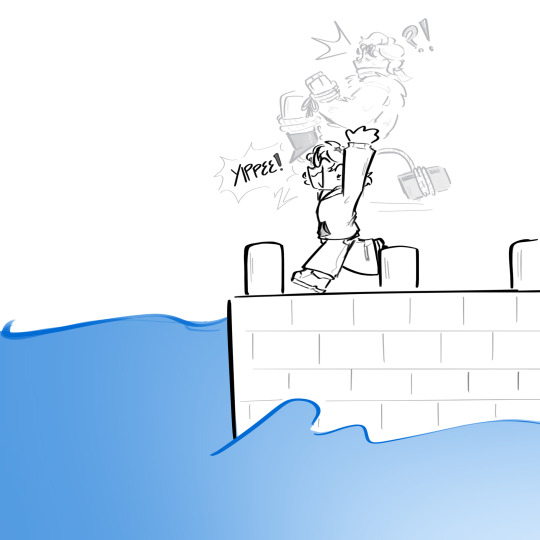#cinder blocks
Explore tagged Tumblr posts
Text

Screenshot Polaroid 022, Rainbow Forest, Google Street View, 2024
#art#design#public art#architecture#rainbow forest#google street view#screenshot#polaroid#photography#screenshot polaroid#Athens#Athens Georgia#cinder blocks#columns#grid
24 notes
·
View notes
Text

#photo#photography#cinderblocks#cinder blocks#water#stream#rain#forest#woods#path#trail#moss#trees#stepping stones
8 notes
·
View notes
Text

Adam Parker Smith - “Fearlessly The Idiot Faces The Crowd” - 2019
2 notes
·
View notes
Text
5 Common Mistakes to Avoid When Landscaping with Concrete Blocks
Landscaping with concrete blocks has become a go-to solution for outdoor design projects. From retaining walls and raised garden beds to patios, seating, and fire pits, concrete blocks offer strength, durability, and flexibility.
But despite their advantages, they are not foolproof. One wrong step—especially in planning or installation—can lead to expensive repairs or disappointing results. Whether you're a seasoned landscaper or a weekend DIY warrior, understanding the most common mistakes can save you both time and frustration.
Here are the five biggest mistakes to avoid when using concrete blocks in landscaping, along with expert tips on how to get it right from the ground up.
Mistake 1: Ignoring Drainage Requirements
One of the most damaging yet frequently overlooked errors in landscaping with concrete blocks is neglecting proper drainage—especially when constructing retaining walls.
Concrete blocks are strong, but they are not designed to hold back water. Without proper drainage, water can build up behind the wall, creating hydrostatic pressure that pushes the wall forward or causes it to bulge and crack.
If you skip proper drainage, your beautifully stacked wall could start leaning or collapsing within a season—particularly in wetter climates like New Zealand’s.
How to Avoid It:
Always include a gravel backfill behind the wall to allow water to drain freely.
Lay a perforated drainage pipe (also known as a weeping tile) at the base of the wall.
Incorporate weep holes at regular intervals to allow excess water to escape.
Use geotextile fabric to separate soil from gravel and prevent clogging.
Failing to manage water is one of the quickest ways to ruin a retaining wall made with retaining wall blocks—so always plan for drainage before you start stacking.
Mistake 2: Skipping a Proper Base or Foundation
No matter how solid concrete blocks are, they’re only as reliable as the foundation beneath them. Skipping or poorly preparing the base is a mistake that will come back to haunt you.
When blocks are laid directly on soil or uneven surfaces, they can shift over time, creating misalignment, cracking, or wall failure.
How to Avoid It:
Excavate a trench below your intended wall or block line. The depth depends on the height of your project but typically should be at least 150mm.
Fill the trench with well-compacted crushed rock or gravel. Compact it thoroughly using a hand tamper or plate compactor.
Add a thin leveling layer of sand or fine gravel to ensure precision before placing your first course of blocks.
The first row of blocks needs to be perfectly level and aligned. Any errors in the base will only get worse as you build upward. A strong foundation is the backbone of any successful concrete block landscaping project.
Mistake 3: Choosing the Wrong Type of Concrete Block
Not all concrete blocks are suitable for every landscaping application. A common mistake is assuming that all blocks are interchangeable, which can compromise both the structural integrity and appearance of your project.
For example, using hollow cinder blocks for a load-bearing retaining wall is not only risky but could lead to dangerous collapses. Likewise, choosing smooth blocks for outdoor steps can create slipping hazards, especially in wet weather.
How to Avoid It:
For retaining walls, use purpose-made retaining wall blocks that interlock or have built-in lips for added stability.
For raised garden beds, lighter decorative blocks or even cinder blocks may suffice if they’re not under pressure.
For steps and stairs, choose blocks with a rough or textured surface to enhance grip.
For fire pits, ensure your blocks are fire-rated or capable of withstanding high temperatures.
If in doubt, speak to your local landscaping supplier and describe your exact use case—they’ll recommend the most suitable block type based on your project’s demands.
Mistake 4: Overlooking Design Aesthetics
Concrete blocks may be utilitarian, but that doesn’t mean your finished landscape has to look cold or industrial. A mistake often made—particularly in DIY projects—is neglecting the overall visual cohesion of the space.
Block-heavy installations can look harsh or out of place when they clash with surrounding architecture, materials, or garden elements.
How to Avoid It:
Select block colours and textures that match or complement your home and other garden features.
Break up hard edges by integrating soft landscaping elements, such as decorative bark, creeping plants, or grasses.
Use white pebbles around block installations to lighten the appearance and contrast earthy tones.
Consider curves, terracing, or multi-level design to create more visual interest than a flat, linear wall.
Don’t underestimate the power of design in landscaping. Even small aesthetic decisions—like block finish or placement—can dramatically affect how inviting your garden space feels.
Mistake 5: Failing to Plan for Future Access or Modifications
When you’re focused on completing a landscaping project, it’s easy to overlook what might happen in five or ten years. But concrete blocks are semi-permanent. If you’ve locked in irrigation lines, buried lighting cables, or limited access to underground services, future maintenance can become a nightmare.
This is especially problematic in large or commercial landscaping where utility work is likely to occur.
How to Avoid It:
Keep conduit pipes or sleeves beneath retaining walls or paths if future cabling might be needed.
Leave inspection points or removable block caps for utility access.
Plan landscaping layouts with expansion in mind—ensure you’re not blocking future garden zones or planned structures.
Avoid building directly over septic lids, irrigation controls, or underground utilities.
Planning for flexibility doesn’t mean sacrificing your current vision—it means future-proofing it. You’ll save yourself headaches down the road by anticipating how your landscape might evolve.
Real-World Example: The Cost of Cutting Corners
A homeowner in Auckland built a 1.5-metre retaining wall using standard concrete blocks on a sloped backyard. They didn’t compact the base, skipped installing a drainage pipe, and stacked the blocks without staggered joints.
By the following winter, heavy rainfall caused soil to expand behind the wall. With no outlet for the water pressure and no reinforced base, the wall cracked in several places and partially collapsed.
In the end, the homeowner had to hire professionals to:
Remove the failed structure
Re-excavate the site
Rebuild with appropriate retaining wall blocks
Add gravel backfill, drainage pipes, and a compacted base
The redo cost more than double the original project—and could have been avoided with proper planning and materials.
Final Thoughts: Build Smarter with Concrete Blocks
Concrete blocks are one of the most dependable building materials in landscape design. When used correctly, they can help you create beautiful, functional, and long-lasting outdoor spaces. But they require thoughtful planning, correct installation, and an eye for both structure and aesthetics.
Let’s recap the top five mistakes to avoid:
Neglecting drainage behind walls
Skipping a proper base or foundation
Using the wrong block type for the job
Ignoring aesthetics and overall design flow
Failing to plan for maintenance or future modifications
Avoid these pitfalls and you’ll be well on your way to a successful landscaping project that not only performs well but looks fantastic for years to come.
Whether you're starting a small DIY garden wall or a large-scale commercial landscaping job, explore high-quality materials like concrete blocks, retaining wall systems, decorative bark, and white pebbles from trusted suppliers.
Source : https://citilandscape.blogspot.com/2025/05/5-common-mistakes-to-avoid-when.html
0 notes
Text
“Ascendant”
© EricBrazier.com
0 notes
Text

1 note
·
View note
Text


He's just a little guy 🥺 (Longlegs belongs to ppl behind @zooliminology)
#please feel free to send this gif onto every discord server you know#give him cinder blocks#zooliminology#longlegs#liminal#liminalcore#liminal spaces#liminal aesthetic#dreamcore#wierdcore#the backrooms#creature#creature design#creature concept#fanart#my art#artists on tumblr#digital illustration#digital art#procreate#silly#gif#pixel art#pixel animation#pixelart#spider#arachnophobia#pixel gif#transparent gif#small gif
1K notes
·
View notes
Text

Screenshot Polaroid 025, Rainbow Forest, Google Street View, 2024
#art#design#architecture#public art#rainbow forest#google street view#screenshot#polaroid#photography#screenshot polaroid#gird#color#cinder blocks#Athens#Athens Georgia#Georgia
18 notes
·
View notes
Text

581 notes
·
View notes
Text

twitter liked this one i love you absolutenutcase162
#kel art#corpse party#birthday bash is literally the best copa game Okay❤️#also i know yoshiki bleaches his eyebrows but idgaf#its cuter like that to have bleached hair + normal dark color eyebrows#drawing yoshiki feels like being hit ober the head with cinder blocks to me but whatever.#yoshiki kishinuma#sakutaro morishige#sachiko shinozaki#morishiki#<- they make me sick in the damn head btw#morishiki is kizashige but awesome because morishige is the one inflicting the damage#and i just like it when yoshiki is in danger#i have 5 trillion sketches but as soon as i have a finished morishiki drawing ill post it Ok
122 notes
·
View notes
Text
How Ready-Mix Concrete Helps in Reducing Construction Costs
In the ever-evolving construction industry, controlling costs while maintaining quality is paramount. Ready-mix concrete has emerged as a transformative solution, offering numerous benefits that contribute to significant cost reductions. This article delves into the various ways ready-mix concrete can optimize construction expenses, ensuring both efficiency and sustainability.
The Economic Advantages of Ready-Mix Concrete
Traditionally, concrete was mixed on-site, a process fraught with challenges such as inconsistent quality and labor-intensive operations. Ready-mix concrete, however, is prepared at a central plant and delivered to the construction site. This shift in methodology provides substantial economic benefits, reducing the need for onsite labor and equipment, thus streamlining operations.
Labor Cost Reduction
One of the most significant ways ready-mix concrete reduces construction costs is by cutting down labor expenses. With ready-mix, the labor required for mixing, transporting, and pouring concrete is significantly minimized. This streamlined process allows construction teams to focus on other critical tasks, enhancing overall productivity.
Moreover, the consistency of ready-mix concrete ensures fewer errors and reworks, saving time and labor costs. For large-scale projects, this can translate into substantial financial savings, especially when combined with other resources like citi landscape supplies.
Minimizing Material Wastage
Material wastage is a common issue in traditional concrete mixing. Ready-mix concrete, delivered in precise quantities, addresses this problem effectively. By ordering the exact amount needed, builders can avoid the costs associated with excess material disposal.
This precision not only reduces waste but also ensures that the project stays on budget. Integrating ready-mix concrete with Auckland landscape supplies further enhances resource efficiency, as materials like concrete blocks and cinder blocks NZ can be seamlessly incorporated into the construction process.
Quality Control and Durability
Ready-mix concrete is produced under strict quality control measures, ensuring a consistent and reliable product. This high level of quality reduces the likelihood of structural issues, thereby lowering long-term maintenance costs. Durable materials like Firth Gobi Block enhance the lifespan of constructions, providing additional savings over time.
The uniformity of ready-mix concrete also contributes to faster project completion, reducing the overall time spent on site and minimizing labor costs. This efficiency is particularly advantageous for projects involving landscaping elements such as Flagstone Pavers or black garden bark.
Time Efficiency and Project Scheduling
Time is a critical factor in construction, directly impacting costs. Ready-mix concrete significantly improves time efficiency by eliminating the need for onsite mixing. The concrete arrives ready to pour, allowing for seamless integration into the construction timeline.
Efficient scheduling reduces downtime and keeps the project on track. For instance, using materials like Gap 7 and Gap 40 alongside ready-mix concrete ensures that groundwork and foundational tasks are completed swiftly, paving the way for subsequent phases.
Resource Optimization
Ready-mix concrete optimizes the use of resources by ensuring that the correct mix ratios are consistently maintained. This precise formulation minimizes the use of raw materials and reduces environmental impact. The integration of sustainable materials, such as Geotextile Fabric and River Stones, further supports eco-friendly construction practices.
By reducing the dependency on onsite mixing equipment, ready-mix concrete also cuts down on fuel consumption and operational costs. This efficiency not only benefits the environment but also aligns with budgetary constraints, making it a preferred choice for modern construction projects.
Long-Term Cost Savings
Investing in ready-mix concrete offers long-term financial benefits. Its durability and low maintenance requirements translate into reduced repair costs over the life of the structure. This is particularly beneficial for infrastructure projects and large-scale developments where longevity is crucial.
Moreover, ready-mix concrete enhances the structural integrity of constructions, ensuring resilience against environmental factors. This robustness is essential for applications such as Fencing Services in Auckland, where durability and stability are paramount.
Conclusion
Ready-mix concrete presents a cost-effective solution for reducing construction expenses. Its benefits, including labor savings, minimal material wastage, and enhanced quality control, make it an indispensable resource for modern construction projects. By integrating ready-mix concrete with other essential supplies like citi landscape supplies, concrete blocks, and Gobi Block, builders can achieve greater efficiency, sustainability, and cost savings.
0 notes
Text







Tallowwood Cabin, Tallebudgera, Australia - Fouché Architects
#Fouché Architects#architecture#design#building#modern architecture#interiors#minimal#house#house design#modern#charred#monochrome#timber cladding#wood architecture#concrete#cinder block#angular#cabin#retreat#beautiful design#forest#nature#trees#wood paneling#kitchen#balcony#fireplace#shower room#australia#cool houses
282 notes
·
View notes
Text
“Torn A Cinder”
© EricBrazier.com

View On WordPress
0 notes
Text

He’s antagonising Dead End [ x ]
#the link is to how he’s tormenting the little guy. but replace dog with cat#I’m just sketching to get back into the groove#smug asshole. I’m going to throw cinder blocks at him#maccadam#transformers#tf astrotrain
132 notes
·
View notes
Note
Let's chuck Spencer into the ocean
Couldn’t agree more anon

#cinder block’s there for extra measures#recently every attempt to draw has ended up looking like him and I can’t stand it anymore#surely this will keep him away for a while#ttte#ttte humanized#ttte gijinka#ttte spencer
65 notes
·
View notes
